|
|
←(Use Google Translate to see an approximate
translation into another relevant language)
|
[General index]
[Index to chapters]
[Index to galleries]
[Full family history]
Arlington, Virginia
In 1956 my dad bought a small house in North Arlington (Virginia) on the
northeast corner of N.23rd and N.Columbus streets. We lived there from
summer 1956 until February 1959, at which time the family relocated to the
Army base at Frankfurt, Germany, with the Arlington house rented to a
temporary tenant. We returned and moved back into the house in mid-1961. I
left for the University of Virginia in Fall 1962 and then joined the Army in
February 1963. This chapter covers the two times I lived in 23rd Street
house. I also lived in Arlington with my Mom and Dad in my Grandmother
Gus's house, N.23rd Street and Glebe Road, 1945-47, but that's covered in
the
Gus chapter.
Dad = My father, Francis da Cruz Sr.
Mom = My mother, Vivian.
Gus = Dad's mother and my grandmother Lenore.
Pete =My father's brother.
—Frank da Cruz <
fdc@columbia.edu>
Most recent update: 11 January 2024 13:52:39
Arlington Ⅱ 1956-59

|
| 4839 N. 23rd Street 1957
|
We moved from rural
Chesterbrook back to
suburban Arlington (4839 N.23rd Street, two blocks from my grandmother's
house) in 1956. We moved because she left her house and all her stuff to
her sons Dad and Pete, who couldn't agree how to divide it up, so they sold
it and my dad used his half of the proceeds to put a down payment on a brick
house built in 1948, which cost $22k. The house was small with a tiny yard
(0.13 acre), a shady screen porch, and eventually a finished (by my dad with
me helping, in knotty pine) basement. It had a cherry tree in the front
yard; we'd get buckets of yellow cherries every Fall. Most of the families
around there were military, but unlike in Chesterbrook they were officers
rather than EMs, but they too had attics full of war souvenirs: Japanese
battle flags, swords, bayonets, German and Japanese rifles and pistols, Nazi
stuff, etc. Most them worked at Fort Myer or Fort Belvior in VA and they
often took me to the bases with their kids to go swimming. Just a few
blocks away was the house of the founder of the American Nazi Party, George
Lincoln Rockwell. Sometimes his people would stuff flyers and leaflets in
our mailbox. He was assassinated at an Arlington laundromat in 1967 by a
disgruntled ex-party-member.

|
| Enlarged house 1998
|
In 2012, according to Google Street View, the house and the entire
neighborhood were exactly as I left them 50 years before, except our house
had been considerably enlarged in 1998; the original house is intact
except for the west wall, where a new wing was added. The white fence my
dad and I built was gone and there was virtually no yard left. The house
sold for $1,175,182.00 in 2016 and by 2020 it was valued at $1,327,182.00.

|
| Air show Andrews Air Force Base 1957
|
During the years before we went to Germany, my dad took us to air shows at
Andrews AFB — lots of military planes to climb up into, as well as
fly-bys, fly-overs, bombing demonstrations, and simulated dogfights. At
first everything was WWII… piston-driven radial-engine propeller
planes, fighers like the Thunderbolt, Hellcat, Corsair, Mustang — when
those things fly right by right in front of you just above ground level at
500mph they are LOUD! — the PBY Catalina seaplane, and the B-17,
B-24, B-25, and B-29 bombers. Living near DC, I would also see these planes
flying overhead all the time. The air shows were an opportunity for the USA
to intimidate the USSR with our military might, and I always saw a Soviet
contingent there.

|
| Felix Ludwig Carrera 1959
|
My parents were friends with some of the people across Columbus Street, and
I was friends with Ludwig Carrera (Felix Ludwig, named after Mendelssohn and
Beethoven), who lived on our side of Columbus Street but across 23rd Street,
two houses over (south); he and his brother and sisters had a big impact on
me, they were kind of like the Glass family in JD Salinger. Ludwig was my
best friend in junior high, and then again in senior year when I came back
from Germany early, and we also went to UVA together, a disaster for both of
us. Later he was in the Army in Vietnam, I saw him a couple times after
that but we never talked about it; I have a feeling it wasn't good. We lost
touch. I can't find him now. I searched for him in Google many times (how
many Felix Ludwig Carreras can there be?) and all I ever found were some old
police records.
Update: In 2022 Ludwig found me, thanks to this
family history; we're back in touch and I'll fill in the blanks later.
The Hall's Hill Segregation Wall
As on outsider, I am absolutely not qualified to write about Hall's Hill;
the following is a brief sketch of the schizophrenia of North Arlington
when I lived there 1956-59 and 1961-62, and the unease I experienced with a
WALL between human beings just across the street from our house, especially
in 1961-62 after returning from 2.5 years on
an Army base in Germany among people of all
races, religions, nationalities, cultures, and economic status and attending
an integrated, diverse high school there. Information on Hall's Hill has been
hard to find until recently but now we have some excellent sources; see
the References section below.

|
| Hall's Hill on Lee Highway near Glebe Road 1950s
|
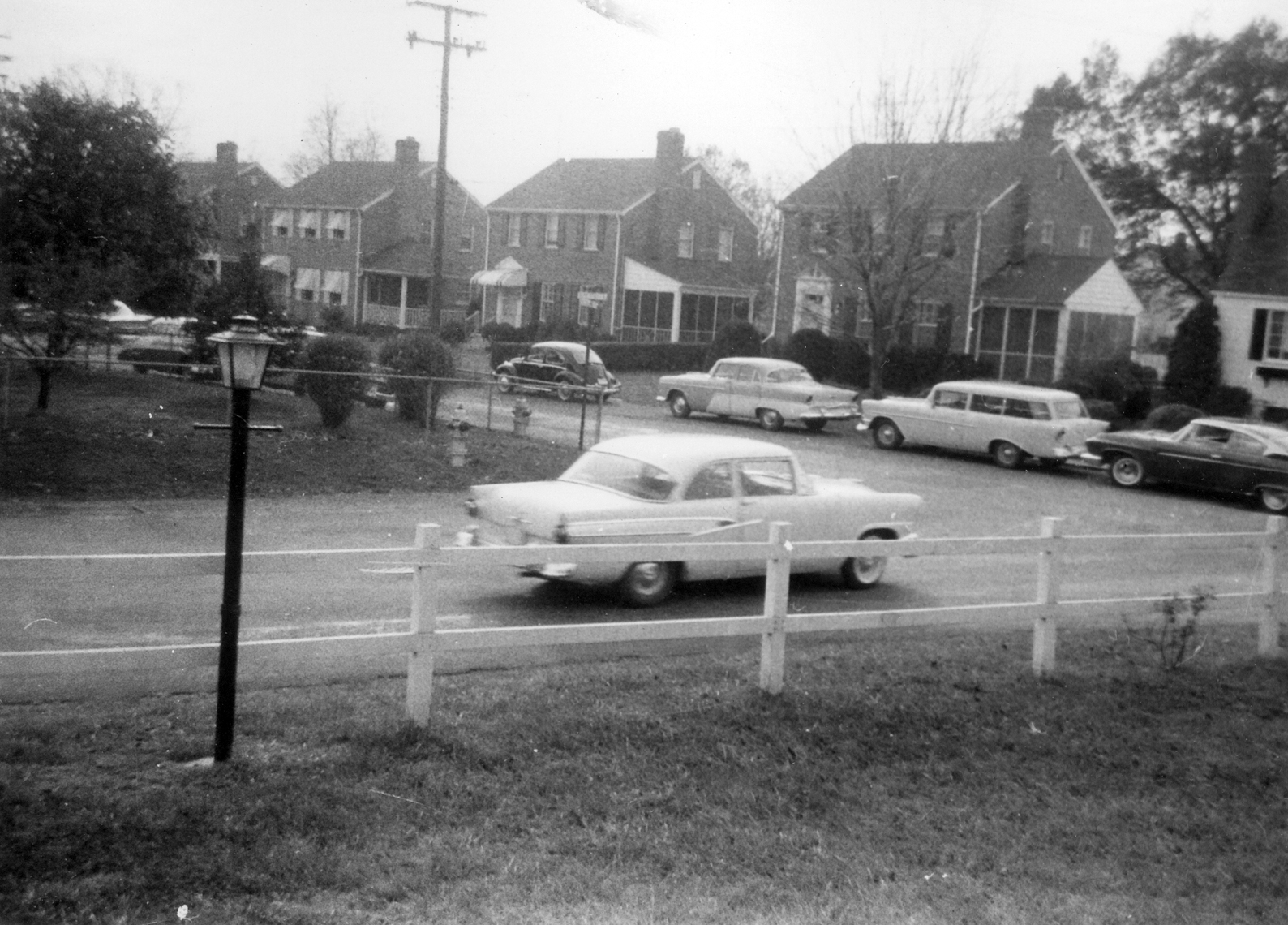
|
| Houses on N. Columbus Street 1956
|
Behind the houses along the other side of Columbus street was a high
wall (not visible in the photo from my bedroom window but just behind the
houses on the right). It separated the white neighborhood from Hall's Hill,
an area settled by former slaves after the Civil War. Virginia was
segregated from the first arrival of African slaves in 1619 until the
mid-1960s. Black and white people had separate neighborhoods and separate
schools and many other impediments to normal life. During and after World
War II, the increase in government jobs in Washington resulted in new white
suburban tracts throughout formerly rural North Arlington. New Black
arrivals moved into enclaves like Hall's Hill, which was walled in to
prevent any contact between white and black residents. It is the only Black
enclave I know of that was
completely surrounded by a wall.

|
| Hall's Hill 2020 (Google) - Click to enlarge
|
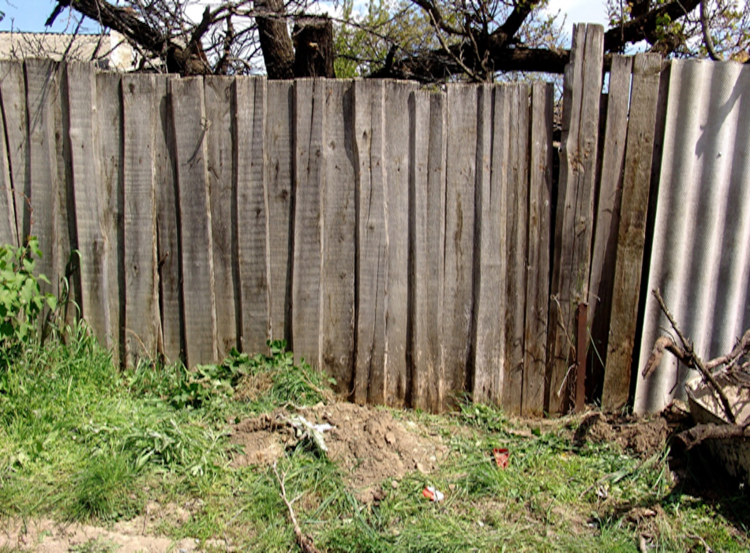
|
| Wooden Hall's Hill wall segment
|

|
| Hall's Hill Masonry wall segment
|
On the modern Google map at left, I traced the outline of Hall's
Hill as best I can, given that I've never seen a proper map of it. Towards
the upper center of the map, the circled A marks
my
grandmother Gus's house on the corner of
N.23rd Street and Glebe Road, where I lived 1945-46, and the circled B marks
the house on N.23rd Street and Columbus Street where we lived 1956-59 and
1961-62, which just is 200 feet from the Hall's Hill wall.

|
| Hall's Hill Segregation Wall historical exhibit
|

|
| Crenellated top of Hall's Hill wall
|
I know the wall went along the backyards of the houses on Columbus Street
from Lee Highway all the way to N.26th Street because I saw it. Other
sources [
4,5,6,12] confirm that it
enclosed all of Hall's Hill. The wall was constructed between 1930 and
1940 by the white occupants of each house on the dividing
line[
4,5,12]. There were only two openings
between Hall's Hill and the outside world: N. Edison Street and
N. Dinwiddie Street, which both opened onto (Robert E.) Lee
Highway, one of Arlington's main thoroughfares and shopping streets. In the
heydey of segregation, the roads within Hall's Hill were all dead ends.
Some of them still are, but since gentrification set in starting about 1979,
some of the roads have been connected to the surrounding streets, as can be
seen on the Google map.

|
| Peoples Drug sit-in 9 June 1960
|

|
| Cherrydale Drug Fair sit-in with Nazis
|
Hall's Hill residents had access to the shopping area at the intersection of
Lee Highway and Glebe Road, and were welcome at the Safeway supermarket on
the corner of Lee Highway and Columbus Street and (as I recall) also the
High's Ice cream store next door to it as well as the nearby hardware store.
They could shop at Robertson's 5&10 but if black children or teenagers
showed up unaccompanied by an adult, the proprietor (Libby) would follow
them around to make sure they didn't steal
anything[
1]. They could also shop at Peoples
Drug Store but could not eat at the lunch counter; this sparked some sit-ins
in 1960, plus "pushback" from the American Nazi Party and its Führer, George
Lincoln Rockwell, who lived nearby[
11]. I was
in Germany during this period.

|
| Evans Coffee Shop about 1960
|

|
| Glebe theater 1945
|
Hall's Hill residents were
not welcome at the barber shop, nor
Glebe theater (1945-72), nor Evans Coffee
Shop[
14,15] (1939-1980, "plantation-style
menu") a snooty place decorated with animal heads and historical memorabilia
and frequented by DAR and Daughters of the Confederacy families.
Nevertheless, Arlington (which until the mid-1930s was home to a thriving
KKK chapter[
1,5,7,8]) fancied itself more
genteel and "tolerant" than the deep south (including non-northern Virginia,
e.g. Charlottesville), so we did not have "White" and "Colored" signs all
over the place, people could sit anywhere they wanted on the WV&M buses
(at least in the early 60s when I was riding them), and Blacks did not have
to step off the sidewalk to make way for whites. There were, however, cross
burnings over the years including at least one when I was living there in
1958[
9].

|
| John M. Langston School 1942
|

|
| Hoffman-Boston High School
|
Hall's Hill residents were hardworking Arlington county taxpayers. Their
local taxes were supposed to go towards the same things white people's taxes
did: water and sewer service, paved streets and sidewalks, gutters, street
lights, trash collection, police and fire department protection, and so on,
plus (from 1954) Supreme-Court mandated separate-but-equal schools. But for
decades water came from wells, bathrooms were outhouses, roads were dark and
not paved until well after WWII, there were no sidewalks and no drainage,
the police never came unless they were looking for somebody and the fire
department would not come at all (so Hall's Hill formed its own volunteer
fire department). As to education, Hall's Hill had its own Langston
Elementary School[
13] (at the center of
the
map where it says Langston-Brown
Community Center). It was extremely convenient but, at least until
1953[
2], had only four rooms. The closest high
school for black teens was Hoffman-Boston: five miles away with no school
bus or public transportation. Getting the Arlington County government to
meet its responsibilities in all of these areas was a struggle over many
decades of which I, who lived practically next door, was completely unaware.
And all this is not even to speak of the decades-long struggle for school
integration, in which, even after Brown-vs-Board-of-Education, Virginia was
a notorious foot-dragger[
1,2,5]. When I
graduated from nearby Yorktown High School in 1962, it was still all white.

|
| Present-day Wall tourists
|

|
| Marker (click to read)
|
By the time Hall's Hill finally had paved roads, running water, and all the
other services it had fought so long and hard for, white people started to
move in and today they are in the large majority. Many of the streets are
reconnected and the wall is mostly gone except for some sections that serve as
tourist attractions. And now, as a New Yorker since 1966, I watch in stunned
disbelief as the same thing happens here to Harlem....
Harlem!!!
Acknowledgments...
...to Cathy Hix, Annette Benbow, and Jessica Kaplan of
the Arlington Historical
Society (AHS) and to Frank O'Leary, former Arlington County Treasurer
and even more former high-school buddy at the Army high school in Frankfurt,
Germany, for connecting me with the folks at AHS. And to Wilma Jones for
writing the book that so badly needed writing!
References:
- Book: Wilma Jones, My
Halls Hill Family: More Than a Neighborhood, self-published (2018).
- Article: Sophie
B. Vogel, The
Integration of Reed Elementary School, Arlington Historical
Magazine, Vol.11 No.1, October 1997, pp. 32-41, accessed at the
Arlington Historical Society website 15 January 2021. This is a PDF file
that starts with a 1963-64 map that, on the mid-to-lower extreme right,
shows bits of Hall's Hill where the dead-ending
of the streets is clearly visible. It notes that in 1925 the John
Langston School at 4864 Lee Highway was established to provide separate but
equal education for the children living on either side of Lee Highway. It
also says that additions were added in 1953, 59, and 64. It also notes that
the process of integration of Arlington schools began on February 2, 1959,
when four Afro-American students were enrolled at Stratford Junior High by
Court order. Four years later, in 1963-64 [the year after I graduated from
nearby all-white Yorktown High School], all secondary schools in the county
were integrated. No action was taken to desegregate at the elementary level
until 1966 — twelve years after Brown-vs-Board-of-Ed; I came back to
Yorktown that year, after the Army, to pick up a transcript and found an
integrated school.
- PhD Dissertation: Nancy Perry,
The
Influence of Geography on the Lives of African American Residents of
Arlington County, Virginia, During Segregation (PDF), George Mason
University (2013).
- PhD Dissertation: Lindsey
Bestebreurtje, Built
by the People Themselves – African American Community Developments in
Arlington, Virginia, from the Civil War through Civil Rights (PDF), George
Mason University (2017): pp.63-75 (history); 208-209 (about the Wall);
213-214 (street lights); 223-224 (KKK); 289-29 (overcrowding); 319-349,
373-377 (schools and integration); 351-353 (infrastructure improvements);
377-393 (gentrification).
- Book: Plat Book of Arlington County,
Virginia, Franklin Survey Company, 2006 Chestnut Street, Philadelphia PA
(1943).
- Article: Hall's Hill Area Due for Renewal,
Northern Virginia Sun, 23 February 1965: "...Negro community of 1650
persons, 322 houses, three churches, and a school... The community is cut
off from Glebe Road by dead-end streets and from any entry on the south side
by four blocks of solid fences and walls running along North 17th Street."
(Thanks to Cassandra Ellison of the VCU Center on Society and Health for
sending me the article as a PDF.)
- Article: Janet Wamsley, The
K.K.K. in Arlington in the 1920s, Arlington Historical Society,
Arlington Historical
Magazine, Vol.10 No.1, October 1993, pp.55-59.
- Masters Thesis: James Lamb, The
Ku Klux Klan in early twentieth Century Virginia, James Madison
University, Summer 2018.
- Article: "Fiery Cross Set Up in
Arlington",
The Washington Post and Times Herald, 23 June 1958, p.B2: "A burning
cross was found yesterday in a cemetery adjoining a Negro church in the 5000
block of Lee Highway, Arlington County Police reported ... made with 7- and
5-foot building timbers ... Reported by the Rev. John F. Monroe of the
Calloway Methodist Church." Thanks to Jessica Kaplan of AHS for this, who
also said "Saundra Green, a long time resident and historian of the area,
had one burned on her front lawn during this period as well."
- Report: A Guide to
the African American Heritage of Arlington County Virginia,
Department of Community Planning, Housing and Development Historic
Preservation Program, Second Edition (2016). Covers Hall's Hill on
pages 12-22 and the Peoples Drug Store lunch counter sit-in on p.57.
- Article: Mark Jones,
Sit-ins Come to Arlington, Boundary Stones (WETA history site),
22 June 2014. The first photo shows Gwendolyn Greene at the counter of
the Peoples Drug at Lee Highway and Old Dominion Drive, which is about
500 feet from Hall's Hill. The Cherrydale Drug Fair was about a mile
to the east on Lee Highway.
- Article: Lindsey Bestebreurtje, A View from Hall's Hill: African
American Community Development in Arlington, Virginia from the Civil
War to the Turn of the Century
Arlington Historical Magazine, Vol.15 No.3 (2015), pp.19-34:
"(the) wall construction was executed on an individual home-owner level,
however, it was planned out enough that by the early 1940s the entirety of
Hall's Hill was quartered off ... the wall meant that the community could
not expand..."
- Article: Nellie C. Stewart, History of
Langston School (origin unknown, written some time after 1960;
Wilma Jones found it among her mother's papers)
[audio]
- A
Guide to the Bayard D. Evans Collection, Fairfax County Public Library.
- Obituary: Bayard
Evans, Restaurateur, Washington Post, September 8, 1980:
"Its furnishings included a much-admired array of historical memorabilia,
including weapons, portraits and tools that predated the Revolution, as
well as a collection of items that related to Robert E. Lee."
- There are examples of segregation walls that do not totally enclose the
Black enclave; for example, the wall erected in Detroit when a new white
subdivision was constructed on empty land next to an existing Black
community, the The
Detroit Eight Mile Wall (Wikipedia, accessed 26 January 2021).
Another example is
the Liberty
City wall in Miami.
- Book: Arlington Historical Society, Arlington,
Images of America series, Arcadia Publishing (2000). Has a few photographs
of and words about Hall's Hill.
Junior High School
Our part of Arlington (except for the stores) is one of the only areas were
I lived as a kid that is still mostly intact. Another is 19th Street SE in
DC, the first place I ever lived (1944-45).
But
Chesterbrook and all of rural Northern
Virginia is gone, and so is
Frankfurt, Germany,
as I knew it.

|
| Williamsburg Junior High School
|

|
| Williamsburg JHS jacket 1957
|

|
| Worms for sale
|
Anyway, in Arlington I went to Williamsburg Junior HS, very suburban, a
big shock for a country boy. I was an 11-year-old hick, and the suburban
boys my age were already partying and dancing and dating, some of them even
having sex. I was extremely shy. It was not a happy time, but Ludwig and I
and some other kids hung out, listened to R&B, played ball, etc. Some of
our friends were hoods who wound up in reformatories. One summer I was on a
softball team that traveled around northern Virginia on buses; I was good at
baseball but I could never get used to softball. The "worms" in the color
picture... I made them at home and sold them in school; I must have sold
100 of them. I forget what I charged; something between 10 cents and a
dollar. Speaking of school and to show how times have changed, every year
we had a shop class (wood, metal, plastic), a music class, and an art class.

|
| Jamestown church 1957
|
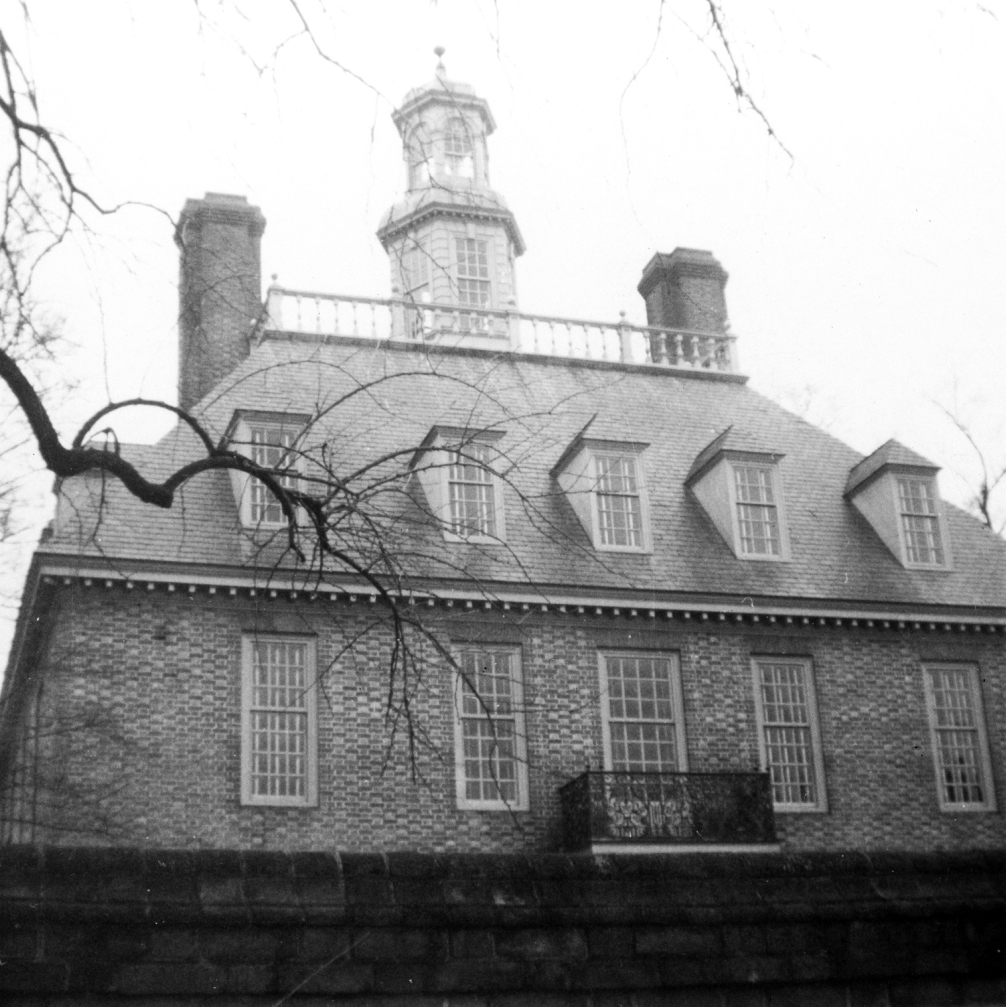
|
| Williamsburg VA 1957
|
In 7th grade we had a big class trip to Colonial Williamsburg and Jamestown,
we stayed there several days. Williamsburg is kind of like a theme park but
Jamestown was more interesting even though it was just old ruins in the
woods by the river; it wasn't all corporate.
By the way, from elementary school through my Masters Degree I did very well
in school. Except in Arlington. The culture there was toxic; only sissies
got good grades. All my friends had total contempt for school and I went
along with them through junior high, and then senior year after Germany, and
got pretty bad grades too. But in Frankfurt there was no stigma at all
attached to doing well in school, you could be cool and get good grades at
the same time, and I did.
And of course Arlington schools were strictly segregated, much more so than
rural Chesterbrook, which was kind of loose. The small-minded cliquishness
was oppressive. One day after school a classmate invited me to his house.
There I saw some books with funny writing on the spines, I said "what's
that?", he said "It's Hebrew, we're Jewish... Pleeeease don't tell anybody!"
Anyway, fast forward to 2020. The area is mostly the same except
for the businesses along Lee Highway and Glebe Road. Ludwig's house (2243
N. Columbus St) is still there, exactly the same. Ludwig's family was one
of the few non-military ones; his dad was an Italian barber who rarely
spoke. His mother was Austrian, about a head taller than his father and
highly cultured. An Odd Couple, united by their mutual love of classical
music. Also odd (it only now occurs to me) because they both came from
Fascist countries, fleeing most likely; I never thought to ask them about
it. There was a big piano in the living room with busts of Beethoven and
Mozart. Ludwig's dad played violin in an orchestra. As traditional in
Italian families, Ludwig's dad made a pasta dinner every Wednesday. There
was always a huge tin of olive oil on the kitchen floor by the door,
probably something like 10 gallons.
Science fiction and space travel were a big part of popular culture when I
lived in Arlington, and in 1957 when Sputnik (the first earth satellite) was
launched I saw it cross the night sky. By contrast, the nineteen-teens and
twenties always seemed quaint and flimsy and long ago to me, even as a
child. The 1930s were not that long ago then; it was when my parents were
teenagers and young adults. For me, "modern times" begins in 1936; you can
see it in the movies — suddenly they are sharp and clear; cars and
airplanes are sleek and solid, not rickety old boxlike contraptions; people
look and talk normal, and the jazz and swing music is not that tinny cutesy
stuff from before.
Up until about the mid-1960s, there was constant fear of nuclear war stoked
by the government, school, news, and movies (most horror films were about
monsters that were mutations from fallout from A-bomb testing). Every town
had an air raid siren. For kids there were constant air-raid and "duck and
cover" drills in school. Everybody was expected to believe that the
missiles would come at any moment and only a strong military could save us.
The greatest threat actually came from the USA, which came close to
launching nuclear strikes several times since WWII, e.g. to wipe out the
Soviet Union after VJ Day, and in Korea when the war started there in
1950, and even after Eisenhower became President.

|
| Nike missile 1957
|
In the early 50s, anti-aircraft guided missile batteries started popping up
all around Washington DC area: the new Nike surface-to-air missiles
[
video], you could
see them all over the place; the picture at left is by me. Guided missiles
were a new thing. The USA was using its German scientists to show us how to
make them. There's a 1954 John Wayne movie,
High and Mighty (the
very first disaster movie, I think) that has a brief scene of American
scientists experimenting with guided missiles and the missile they were
experimenting with was a Nazi V-1 "buzz bomb" painted bright yellow.
Speaking of rockets, I read a lot of science fiction as kid in the 1950s,
books as well as those paperback-book size like magazines Fantasy and
Science Fiction, Analog, If, and Galaxy (the first "adult" book I read
was The Martian Chronicals by Ray Bradbury around age 10). But
never, not once, not even in their most wild imaginings, did any of these
imaginative writers ever foresee that space exploration would be outsourced
to private for-profit companies! (Recent headline from corporate media:
"2021 could be a huge year for space; what's to come from Elon Musk, Richard
Branson, and Jeff Bezos!" Hurray for selfish, greedy, arrogant billionaires!)
Aside from science fiction, I read a lot of adult books as a kid. You could
buy paperback books ("pocket books") at the drugstore for 35 cents. I read
books by Steinbeck (Grapes of Wrath, Travels with Charlie), Remarque (All
Quiet on the Western Front), James Jones (From Here to Eternity), Graham
Greene (The Quiet American), D.H. Lawrence (Fathers and Sons), Mark Twain
(Letters from the Earth), McKinley Kantor (Andersonville), Leslie Charteris
("The Saint" mysteries from the 1920s that Uncle Pete was addicted to), and
other authors including John O'Hara, Leon Uris, Irving Stone, Herman Wouk,
Evelyn Waugh, Pearl S. Buck, Somerset Maugham, Daphne du Maurier, John
Hersey, Nevil Shute, Robert Ruark… either I bought them at random or
they were laying around the house.
Arlington III: Back in Virginia 1961-62
Back in Arlington after
2½ years in
Germany, our house was not vacated yet. We had to stay with my dad's
Aunt Bess and Uncle Bill in Maryland for a week or two while the tenant
moved out. The only thing I remember about that is I read the entire works
of Poe because they were in the bedroom where I slept, and I figured out how
to play "There is a Rose in Spanish Harlem" on the piano in the basement.
Then we moved back into our old house on N. 23rd Street. The tenant while
we were gone was a Marine sergeant who had painted the entire inside olive
drab… Including even the fireplace bricks. My dad scraped it all off
and put it back like it was.

|
| Yorktown high school 1962
|

|
| Me, yearbook photo
|
I had my senior year at Yorktown HS in Arlington, antiseptic,
suburban, conformist, patriotic, segregated. I did not like
Yorktown or Arlington or the suburbs one bit and cut class and got drunk all
the time, but still managed to do OK on my SATs (despite having a huge
hangover) and graduated on time in 1962. YHS was kind of posh and elite
compared to my Army high school; one measure of this is the Vietnam body
count for each school for classes up to
1962:
Frankfurt: 19,
Yorktown: 0.
Of course that's a bit skewed since FHS is older but if even if we just look
at the class of the 1962 it's still 4 and 0. Yorktown graduates were
much more likely to go straight to college, which is a draft exemption.
More about this
below.
The only good thing about that year was the music: the Shirelles, the
Marvelettes, Mary Wells, Jimmy Reed, Ike and Tina Turner, the Isley
Brothers… It was kind of a renaissance of Black music after the
drought that started in 1957 when 1940s-50s R&B era ended and there was
only cheesy pop music for a few years (and jazz, of course, but that's
another story).
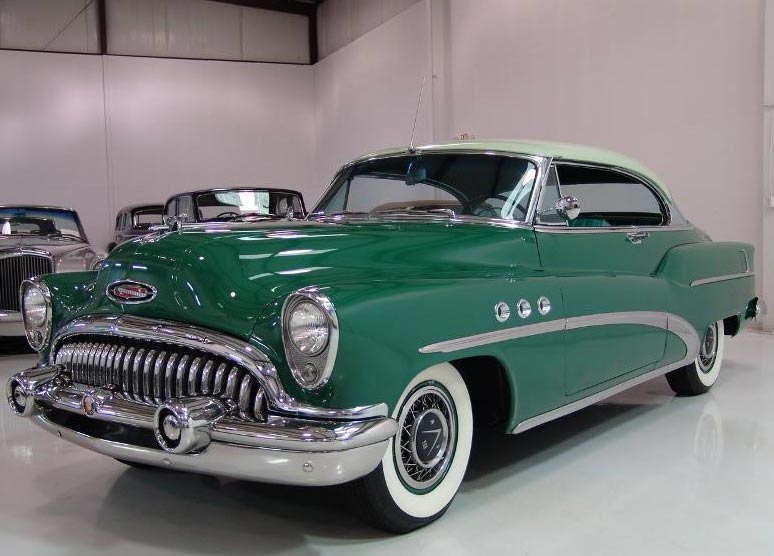
|
| 1953 Buick (nicer than Ludwig's)
|
Almost all the kids at Yorktown had their own cars and drove to school, so I
rode around in cars a lot that year. Ludwig was not at Yorktown (he was
blacklisted and had to go to another school far away), but he had a 1953
Buick, which was like tank. A guy named Pete Washburn was generally

|
| Pete Washburn
|
acknowledged as the coolest guy at Yorktown and for some reason he thought I
was cool too. Graham Chapman was clone of him. He had a 1950 Ford and
would pick me up in the morning, we'd stop at a diner and have coffee and
hash browns for breakfast which probably made my Mom feel bad because my
whole life she always made us a hot breakfast. A couple times Mom made us a
special breakfast so we wouldn't go to the diner. Pete pretended to be like
a homeless drifter, nobody knew anything about him. He finally showed me
where he lived, a mansion!

|
| 1939 Ford Coupe hotrod
|

|
| Customized 1950 Ford similar to Pete's
|
The preferred cars for cool guys were the 1950 Ford and the 1939 Ford coupe,
both heavily customized. The Ford had to be painted with grey primer (matte
finish) and have its front grille removed, plus had to be either "raised" or
"lowered" (big wheels in front, small ones in back, or vice-versa). A
special glasspack muffler was required that produced a sort of
Harley-Davidson sound.
Optionally it could also be "chopped and channeled", "bored and stroked",
and/or "rolled and pleated". I never was totally sure what things were but
the first two have to do with the engine, the latter with the upholstery.
The 1939 Ford was always painted Candyapple Red and had its hood off so the
souped-up motor was exposed. Drag races were common, and some guys even
raced at real dragstrips like Manassas Speedway, we went there sometimes to
watch. At the speedway, the mufflers came totally off and the cars were as
loud as 747s. Unlike a lot of my friends, I never learned to be an auto
mechanic or a car customizer. Incidentally when my dad finally advertised
his beloved 1950 Ford for sale, it was bought by a drag racer.
Ludwig was the bad boy of his family, the other three (Nick, Carole, and
Maria) were great successes in whatever they did, but Ludwig always screwed
up and got in trouble. We were inseparable during 12th grade, because we
both had a compulsion to be drunk all the time. We'd drive to DC, buy a
case of beer with false ID, and then drive around Arlington drinking it and
throwing cans out the window until we got sick. Even then, Ludwig would
keep driving and drinking, door open, puking his guts out on the street
while still driving the car. That's how miserable we both were that year.
Once Ludwig's mom loaned him her tiny little red Renault, I don't remember
why. We bought some big 40-ounce bottles of Country Club Malt Liquor
(high-alcohol beer) and were driving around downtown DC after we had already
gone through several of the bottles, looking for a parking space. I saw one
and pointed it out. The next thing I knew we had crashed into the back of
the car in front of us… And it was a Police car! And our car was
full of empty beer bottles! Just then a street guy comes up and says "Give
me the bottles", and we did, so by the time the cops came to the car we were
clean. But the car was totaled. Renaults have their engine in back and
their trunk in front, so we pretty much just squashed the whole front of the
car under the back of the police car, which didn't even have a scratch.
They took us to the station, called Ludwig's mother; Lud was released into
her custody and was in the doghouse for the rest of his life. But since we
weren't caught drinking, there were no criminal charges.
Btw, Maria Carrera was my brother's best friend that year, they were very
close. When Dennis was dying, my dad used his special powers to track her
down at a commune in the mountains of Colorado so she could call him
in the hospital. I don't know what happened to her after that.

|
| Tops Drive-In
|
Anyway the Arlington car culture was pretty much what you see in movies like
American Graffiti and
Remember the Titans, all the males
"cruising" around all the time looking for girls or parties or whatever, and
also pulling into Tops Drive‑In on Lee Highway, one of those places
where you park your car and order stuff through a microphone mounted next to
the space, and girls (on roller skates?) bring your order to you on a tray
that clips to the car window, to the tunes of Sam Cooke, Gary US Bonds, Ike
and Tina Turner, Gene Chandler, Little Eva, the Contours...
Incidentally, the last fight I was involved in was in 12th grade in
Arlington, when my band (but not me personally) got in trouble with John
Glenn, the astronaut and future senator, who had just returned from
America's first space mission. It was in all the papers, you can still find
it in Google (it was February or March, 1962). I guess Peter will want the
whole story so…
Our band had a gig at a junior-high-school girl's birthday party
in her house in suburbs. Our singer (don't recall his name but
he was just like Sean Penn) was quite a handful, and this time he
brought a fifth of whisky and was taking big slugs out of it in
front of everybody; I guess the parents were too terrorized to
say anything. But the rest of us were drinking beer at a pretty
good clip too, but more discretely; we had stored it outside in
the snow to hide it from the parents. About 9:00pm John Glenn
shows up, he's picking up his daughter who is at the party; he
sees what is going on — first the beer cans littering the front
yard, then our singer chugging down whisky between verses — and
throws us out. We didn't even get paid!
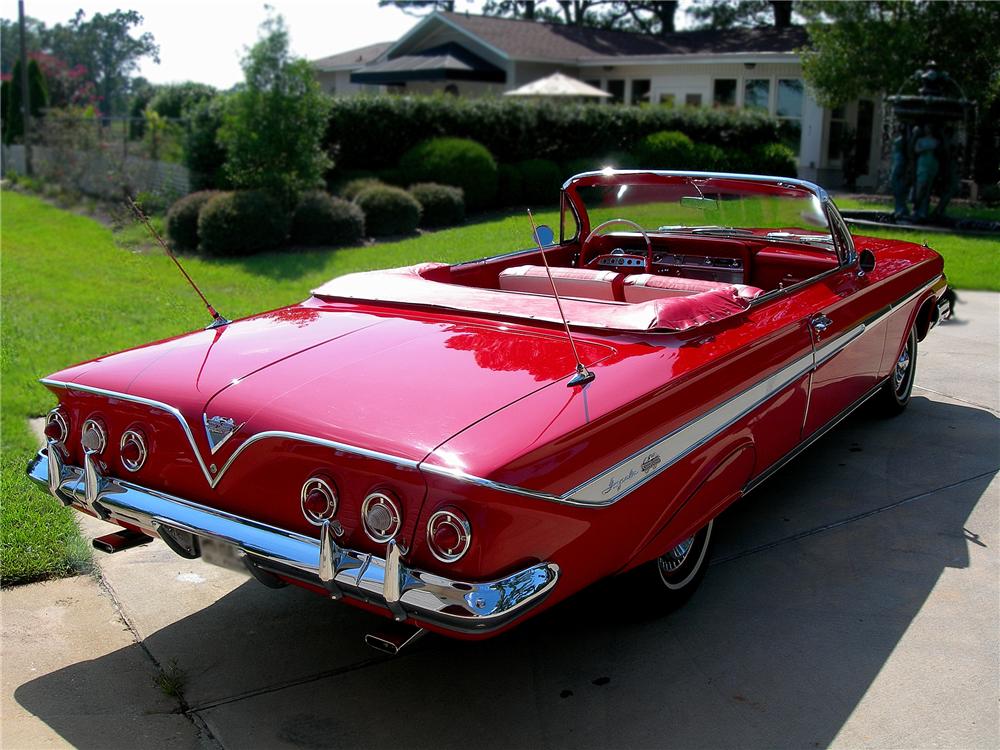
|
| Early 1960s Chevrolet Impala convertible
|

|
| Who John Glenn is
|
Our piano player had the use of his parents' car, a 21-foot long bright red
Chevrolet Impala convertible. So we were cruising around looking for
something else to do and we found another junior-high-school party in the
parking lot of a church so we pulled in and started playing music. A strange
thing I remember is that on the far side of the parking lot, on top of a
hill, a house was burning down, and we improvised some kind of creepy
apocalyptic accompaniment. What can I say, we were teenage boys. We were
still drinking and throwing beer cans around and who should pull into the
parking lot but John Glenn! To pick up his other child.
Our singer who was blind drunk by this time and pissed off about not being
paid, when Glenn approached us, the singer tried to punch him in face, but
Glenn deflected the punch and spun the guy around and laid him out over the
car hood, like a cop would do. I don't recall exactly what happened after
that; we weren't arrested or anything, I think we just left. But the next
morning it was on the news, and in the papers, and it was in the next issue
of Time Magazine. Drunken Teenage Punks Attack America's Greatest Hero.
And we were in Big Trouble for the rest of the year. Sometimes I even
thought we were being followed, but who knows; it's not inconceivable that
my dad put a tail on us.
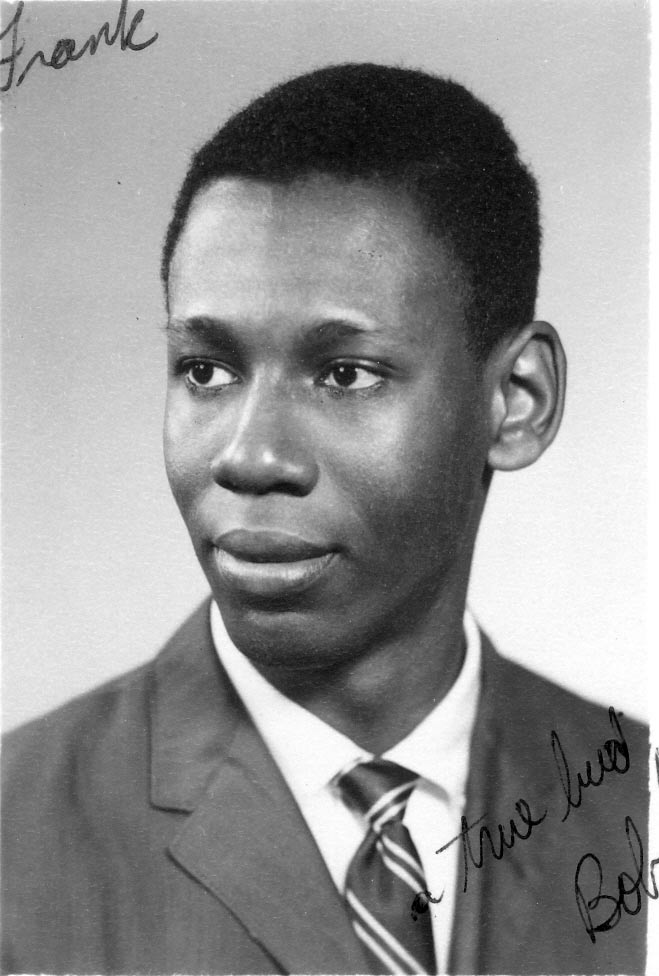
|
| Bob Engs 1962
|

|
| Williamsburg windmill
|
Bob Engs had been my friend in Frankfurt in 1959-60. His dad had been a
Captain but was "RIF'd" down to Sergeant, a very humiliating thing to happen
but he stuck it out so he could retire. Bob came back a year before me; his
dad was stationed in Fort Eustis VA, near Jamestown and Williamsburg and
Newport News and they lived on base. I went there in summer of 1961 before
school started and spent a couple weeks with them. Bob had a summer job at
Colonial Williamsburg in the windmill, I'd go with him and spent the days
grinding dry hominy into grits for the tourists, even though I didn't have a
colonial costume like Bob did; I was like Bob's apprentice from the future.
Each morning we'd turn the mill around to face the wind (it was on a pivot)
and then unfurl the sails so the huge "propeller" (sweeps) could turn in the
wind and drive the massive millstone, but we used smaller muscle-powered
wheels (hundreds of years old and not exactly lightweight) to do the actual
grinding.
Later that year, Mom and I played a trick on my dad, we invited Bob and his
family to our house for dinner, which was a truly surreal experience, when
my dad saw them he almost had a heart attack but he behaved himself while
they were there. But afterwards, you can imagine. Later Bob went to
Princeton (I saw him there after I got out of Army) and he went on to become
a well-known professor of Black History; you can look him up in Google
(Robert F. Engs) and in the Books section of Amazon. I went to his wedding,
and later Mommie and I went to visit him in NJ and it was a very strange
experience, he was mean to both Mommy and to his own wife (a Black woman).
I never saw him again, but he got in touch with me by email in 2008 to
apologize and we exchanged a few cordial emails, and then he died.
High-school graduation night Ludwig and I and a couple other guys went to
Ocean City MD in Ludwig's 1953 Buick for a week.
In those days Ocean City was just a strip of seedy white wooden boarding
houses alongside a 2-lane road, with the beach on the other side of the
road. Every house had a porch on both the first floor and the second floor,
like houses in the French Quarter of New Orleans; we had the upper floor
porch, where we'd sit and drink beer for breakfast before going to the beach
to drink more beer.
Each day we'd drink until we passed out, wherever we happened to be. One
morning I woke up on the beach half buried in sand with a bad sunburn on one
side of my body but not the other. So that was high school.

|
| Elaine Neam
|
Having written all of the above, I looked at my Yorktown yearbook for the
first time in 50-some years and found some surprisingly affectionate
inscriptions from several girls I knew including one — Elaine Neam
— who I had known since 7th grade and who I always liked a lot, but
aside from seeing Chloris Kranich* occasionally that year, and a few other
random encounters, I was way too busy drinking (i.e. too much of a
jerk) to have a real girlfriend. Anyway I was just about the only one in
school who didn't have a car, or even access to one, so not exactly a great
catch in the suburban car culture.
But if somehow I had married Elaine instead of
Mommy,
Uncle Pete's children would not be the
only ones in the family who were half Lebanese!
Vietnam

|
| Art Goldtein
|
There was a Class of '62 reunion in 2023 (the 61st, I didn't go). One of
the organizers, Art Goldstein, put together a list of classmates who had
died, which included some of my long-ago friends. I wondered if any of
them had been killed in the Vietnam War, since alumni of my previous high
school,
Frankfurt High School in West Germany,
have a list of "
fallen
eagles" that shows a total 27 Vietnam deaths from all classes 1950-1968.
But nobody knew about Yorktown.
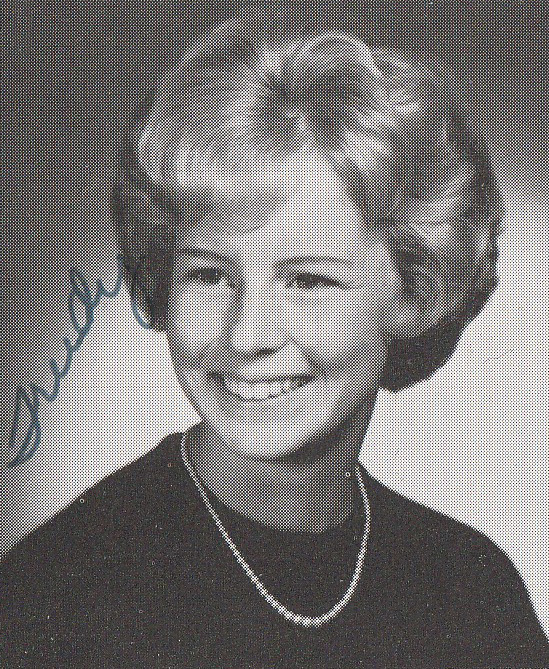
|
| Trudy Harlow
|
So I looked up each name in the 1962 yearbook and then also at
VirtualWall.org (the
online list of names from the Vietnam Veterans Memorial in DC). There were
8 name matches, but the ages weren't right and/or the Virtual Wall photos
did not match the yearbook ones. But then my YHS classmate Trudy Harlow
wondered if any had gone to Vietnam and returned safely, only to die later
from Agent Orange exposure or other war-related cause. There's a database
for that too: the
In Memory
Honor Roll. But this too turned up nobody in our class.

|
| Lynda Van Devanter
|
But there was a schoolmate from Yorktown class of '65,
Lynda Van Devanter, a sophomore when we were
seniors. After graduation she trained as a nurse, volunteered for
Vietnam duty, then worked at the 71st Evacuation Hospital in Pleiku
(and later in Qui Nhon), and returned with PTSD. In 1983 she wrote a book
about it —
Home
Before Morning — on which the TV
series
China Beach
was based, and devoted her life to women Vietnam veterans with PTSD until
she died in 2002 from Agent Orange poisoning.








































